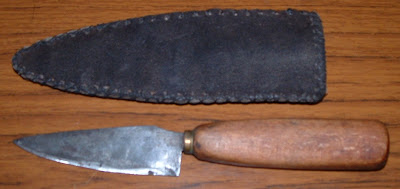
The belt knife was/is a hunting knife, it is used to skin and butcher game, for protection, and for eating with. Often a second knife was carried, and sometimes a third, each had a specific use. A second back-up skinning knife might be carried in the top of the legging or under the waist belt or hanging round the neck. A third might be carried for camp chores in the form of a fixed blade or a clasp knife. The problem with only carrying one knife these days is that if it is lost or damaged, you have nothing else. Nothing to cut with, and nothing to scrape your ferrocium rod with!
I am not sure how other people put their outdoors/camping/trekking/survival gear together, but I always ask myself, "what if".






5 comments:
I think there are a few reasons: one is people's sacred cows, another one is Ray Mears' influence, another is the worry about the knife laws that can lend you in serious trouble if you have the misfortune to cross path with a "jobsworth" police man. I probably don't look like much trouble, just an oldish guy walking his dog! A dog is a very good alibi for being out and about...I much prefer my wood craft stuff to be made of natural material, wood, leather, most of it hand made by me, or obtained through trades. I found that much more satisfying.
Thanks for the feedback Joel, much appreciated.
Keith,
I have always wondered, with regards to the butcher knife, about the sheathing and carrying. It looks as if there is no 'secure' attachment to the belt. It would be then much more prone to falling out. Was this something accepted, and kept mindful? Was the belt so tight as to make it hard for its release? Or, as on my Green River butcher, was there a longer 'hidden' belt loop that ran lengthwise on the back of the sheath so it wouldn't fall?
Bryce
No loops Hutch that I am aware of. I have carried my knife this way for many years now, and it has never come out. The belt does hold the knife and the sheath fast. But if you were to be concerned re losing it, it would be quite acceptable to add a leather thong to the sheath to secure it to the belt.
Keith.
That's interesting. I actually noticed that when I was younger, in the movie Last of the Mohicans. It has always seemed to me that surely as they were running up and down the mountains and rivers of New York (or NC, as it were) that it'd fall out. Good to know it doesn't! Thanks!
Post a Comment